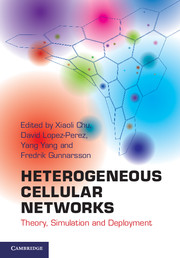Book contents
- Frontmatter
- Contents
- Acknowledgments
- Forewords
- Preface
- List of contributors
- Acronyms
- 1 Introduction
- 2 Radio propagation modeling
- 3 System-level simulation and evaluation models
- 4 Access mechanisms
- 5 Interference modeling and spectrum allocation in two-tier networks
- 6 Self-organization
- 7 Dynamic interference management
- 8 Uncoordinated femtocell deployments
- 9 Mobility and handover management
- 10 Cooperative relaying
- 11 Network MIMO techniques
- 12 Network coding
- 13 Cognitive radio
- 14 Energy-efficient architectures and techniques
- Intex
9 - Mobility and handover management
Published online by Cambridge University Press: 05 June 2013
- Frontmatter
- Contents
- Acknowledgments
- Forewords
- Preface
- List of contributors
- Acronyms
- 1 Introduction
- 2 Radio propagation modeling
- 3 System-level simulation and evaluation models
- 4 Access mechanisms
- 5 Interference modeling and spectrum allocation in two-tier networks
- 6 Self-organization
- 7 Dynamic interference management
- 8 Uncoordinated femtocell deployments
- 9 Mobility and handover management
- 10 Cooperative relaying
- 11 Network MIMO techniques
- 12 Network coding
- 13 Cognitive radio
- 14 Energy-efficient architectures and techniques
- Intex
Summary
Introduction
Compared with current cellular networks, next generation mobile networks are expected to encompass more sophisticated features, including the support of higher data transmission rates and user equipment (UE) mobility, location management, diversified service levels, etc. In order to accommodate these requirements, the 3rd Generation Partnership Project (3GPP) is devoted to the standardization of Long Term Evolution (LTE) and LTE-Advanced systems, which have been recognized as major candidates for the fourth-generation (4G) mobile networks. In LTE/LTE-Advanced systems, the network structure will be heterogeneous. How to maintain and improve mobility, handover (HO), and location management, while avoiding user experience deterioration, is a challenging task. In this chapter, we will study the mobility management challenge and illustrate advanced mobility management schemes.
In LTE/LTE-Advanced systems, the factors that make mobility, HO, and location management a challenging task are as follows
The rapid evolution of cellular networks results in the coexistence of multiple radio access technologies (RATs), e.g., Global System for Mobile Communications (GSM), Universal Mobile Telecommunication System (UMTS) and LTE/System Architecture Evolution (SAE). This demands optimized cooperation among multiple RATs to enable UEs to roam from one RAT to another.
The introduction of low-power nodes (LPNs) largely increases the total number of base stations (BSs), making the network structure and interference conditions more intricate. Thus, traditional mobility load balancing (MLB) and mobility management schemes need to be revisited to suit the new heterogeneous cellular network (HCN) architecture.
The complexity of LTE/LTE-Advanced systems leads to a large number of network parameters. Therefore, efforts need to be made in defining proper key performance indicators and developing optimization techniques for mobility management in various scenarios.
- Type
- Chapter
- Information
- Heterogeneous Cellular NetworksTheory, Simulation and Deployment, pp. 245 - 283Publisher: Cambridge University PressPrint publication year: 2013
- 5
- Cited by

